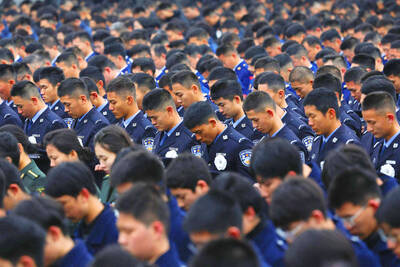They stand as eyesores to most passers-by and potential public health risks to authorities, decaying buildings wrapped in tangles of exposed wire, studded with protruding leaky plastic pipes, vegetation billowing from cracks and terraces where particulates from polluted air have accumulated over time.
With skyscrapers and ultramodern developments on every side, some of these “nail houses” are also sitting on land worth millions of dollars in Shenzhen’s inferno of a property market, where new-unit and second-hand home prices rival London.
In battles over land and development, the nail house phenomenon has become widespread throughout China over the past two decades, with owners of the structures refusing to move to make way for new construction projects until they receive what they believe is their rightful compensation.
Sandwiched between two 20-plus-story residential complexes in the heart of Shenzhen’s Louhu District sits one such building that has fallen into disrepair.
The three-story building now essentially has no development value after its owner held out too long. Its most likely fate is to become a parking lot.
“The owner is still asking for about 100 million yuan [US$14.35 million], but now it is nearly worthless. He cannot sell it,” a middle-aged woman who rents in the building said, declining to provide her name.
The megacity of about 18 million people is hoping that a new proposal will rid the city of nail houses for good, and bring to an end land disputes that can sometimes drag on for a decade.
The plan would greenlight projects if 95 percent of the owners agree to relocate. The previous policy required all owners to approve, often leading to a handful of holdouts hoping to secure higher compensation.
The draft policy also sets minimum standards for the payout, which translates into either a home or homes of equivalent size and value elsewhere in Shenzhen, or cash payments based on space and property values.
Qiao Shitong (喬仕彤), an assistant law professor at the University of Hong Kong who has studied the city’s small property system extensively, said that Shenzhen has tried to move forward similar policies in the past, but had too much pushback from property owners and village committees.
“But this one might be successful,” Qiao said by telephone. “People appear to think it is more reasonable to do it this way now.”
“Before it was a conflict between developers and nail house owners, and now under this policy it would be a conflict between you and your neighbor,” he said. “It is becoming more common to use peer pressure to solve these issues.”

PARLIAMENT CHAOS: Police forcibly removed Brazilian Deputy Glauber Braga after he called the legislation part of a ‘coup offensive’ and occupied the speaker’s chair Brazil’s lower house of Congress early yesterday approved a bill that could slash former Brazilian president Jair Bolsonaro’s prison sentence for plotting a coup, after efforts by a lawmaker to disrupt the proceedings sparked chaos in parliament. Bolsonaro has been serving a 27-year term since last month after his conviction for a scheme to stop Brazilian President Luiz Inacio Lula da Silva from taking office after the 2022 election. Lawmakers had been discussing a bill that would significantly reduce sentences for several crimes, including attempting a coup d’etat — opening up the prospect that Bolsonaro, 70, could have his sentence cut to

China yesterday held a low-key memorial ceremony for the 1937 Nanjing Massacre, with Chinese President Xi Jinping (習近平) not attending, despite a diplomatic crisis between Beijing and Tokyo over Taiwan. Beijing has raged at Tokyo since Japanese Prime Minister Sanae Takaichi last month said that a hypothetical Chinese attack on Taiwan could trigger a military response from Japan. China and Japan have long sparred over their painful history. China consistently reminds its people of the 1937 Nanjing Massacre, in which it says Japanese troops killed 300,000 people in what was then its capital. A post-World War II Allied tribunal put the death toll

A passerby could hear the cacophony from miles away in the Argentine capital, the unmistakable sound of 2,397 dogs barking — and breaking the unofficial world record for the largest-ever gathering of golden retrievers. Excitement pulsed through Bosques de Palermo, a sprawling park in Buenos Aires, as golden retriever-owners from all over Argentina transformed the park’s grassy expanse into a sea of bright yellow fur. Dog owners of all ages, their clothes covered in dog hair and stained with slobber, plopped down on picnic blankets with their beloved goldens to take in the surreal sight of so many other, exceptionally similar-looking ones.

‘UNWAVERING ALLIANCE’: The US Department of State said that China’s actions during military drills with Russia were not conducive to regional peace and stability The US on Tuesday criticized China over alleged radar deployments against Japanese military aircraft during a training exercise last week, while Tokyo and Seoul yesterday scrambled jets after Chinese and Russian military aircraft conducted joint patrols near the two countries. The incidents came after Japanese Prime Minister Sanae Takaichi triggered a dispute with Beijing last month with her remarks on how Tokyo might react to a hypothetical Chinese attack on Taiwan. “China’s actions are not conducive to regional peace and stability,” a US Department of State spokesperson said late on Tuesday, referring to the radar incident. “The US-Japan alliance is stronger and more